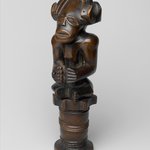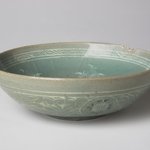
Garden Seat
Asian Art
On View: Asian Galleries, South, 2nd floor
Koreans did not use chairs until the arrival of Western influences in the late nineteenth and early twentieth century. Ceramic garden seats, designed to be left outside and offering a place to rest without sitting on the wet ground, are a rare exception. The use of both iron-brown and cobalt-blue decoration on this piece is typical of Korean porcelains: blue and brown are rarely combined on Chinese wares of any period.
MEDIUM
Porcelain with cobalt and iron decoration under glaze
DATES
early 19th century
DYNASTY
Joseon Dynasty
DIMENSIONS
18 1/2 x 19 3/4in. (47 x 50.2cm)
diameter at mouth: 9 1/8 in. (23.2 cm) (show scale)



COLLECTIONS
Asian Art
ACCESSION NUMBER
86.260.3
CREDIT LINE
Gift of Mr. and Mrs. Herbert Greenberg
CATALOGUE DESCRIPTION
From Accession Card:
White porcelain with cobalt and iron decoration under a clear glaze. A large porcelain Seat for a gentleman scholar's garden. Its carved, openwork decoration depicts grapevines, grape leaves and clusters of grapes. The surface of the grapes was painted with under glaze iron-brown wash. Stylized "precious things" (coins, jewels, treasure bags) a traditional Chinese motif, were drawn in under glaze cobalt blue on the border below the grapes. Grapes were a popular subject in the paintings and decorative arts of Yi Dynasty Korea. Unlike most of the other animal and plant motifs in Korean art, grapes had no auspicious or protective symbolism.
Note: the dynasty is now known as Joseon.
EXHIBITIONS
MUSEUM LOCATION
This item is on view in Asian Galleries, South, 2nd floor
CAPTION
Garden Seat, early 19th century. Porcelain with cobalt and iron decoration under glaze, 18 1/2 x 19 3/4in. (47 x 50.2cm). Brooklyn Museum, Gift of Mr. and Mrs. Herbert Greenberg, 86.260.3. Creative Commons-BY (Photo: Brooklyn Museum, 86.260.3_edited_SL3.jpg)
IMAGE
overall, 86.260.3_edited_SL3.jpg. Brooklyn Museum photograph
"CUR" at the beginning of an image file name means that the image was created by a curatorial staff member. These study images may be digital point-and-shoot photographs, when we don\'t yet have high-quality studio photography, or they may be scans of older negatives, slides, or photographic prints, providing historical documentation of the object.
RIGHTS STATEMENT
Creative Commons-BY
You may download and use Brooklyn Museum images of this three-dimensional work in accordance with a Creative Commons license. Fair use, as understood under the United States Copyright Act, may also apply.
Please include caption information from this page and credit the Brooklyn Museum. If you need a high resolution file, please fill out our online application form (charges apply).
For further information about copyright, we recommend resources at the United States Library of Congress, Cornell University, Copyright and Cultural Institutions: Guidelines for U.S. Libraries, Archives, and Museums, and Copyright Watch.
For more information about the Museum's rights project, including how rights types are assigned, please see our blog posts on copyright.
If you have any information regarding this work and rights to it, please contact copyright@brooklynmuseum.org.
RECORD COMPLETENESS
Not every record you will find here is complete. More information is available for some works than for others, and some entries have been updated more recently. Records are frequently reviewed and revised, and we welcome any additional information you might have.


































